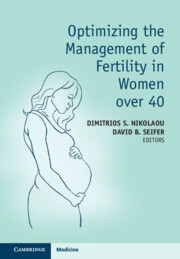Book contents
- Optimizing the Management of Fertility in Women over 40
- Optimizing the Management of Fertility in Women over 40
- Copyright page
- Dedication
- Contents
- Contributors
- Introduction
- Section 1 Demographic Trends
- Chapter 1 Is 40 the New 30? Increasing Reproductive Intentions and Fertility Rates beyond Age 40
- Section 2 Biological Basis of Female Reproductive Aging: What Happens to the Ovaries and the Uterus as they Age?
- Section 3 Lifestyle, Environment, and Optimizing Reproduction in the 40s
- Section 4 Rethinking and Redefining “Family Planning” for the Twenty-First Century
- Section 5 Optimal Deployment of ART beyond 40
- Section 6 Obstetric Management beyond 40
- Section 7 Children of Older Parents
- Section 8 What Are Realistic Alternatives to Conceiving with Autologous Eggs?
- Section 9 New Technologies
- Section 10 Ethics
- Index
- References
Chapter 1 - Is 40 the New 30? Increasing Reproductive Intentions and Fertility Rates beyond Age 40
from Section 1 - Demographic Trends
Published online by Cambridge University Press: 15 September 2022
- Optimizing the Management of Fertility in Women over 40
- Optimizing the Management of Fertility in Women over 40
- Copyright page
- Dedication
- Contents
- Contributors
- Introduction
- Section 1 Demographic Trends
- Chapter 1 Is 40 the New 30? Increasing Reproductive Intentions and Fertility Rates beyond Age 40
- Section 2 Biological Basis of Female Reproductive Aging: What Happens to the Ovaries and the Uterus as they Age?
- Section 3 Lifestyle, Environment, and Optimizing Reproduction in the 40s
- Section 4 Rethinking and Redefining “Family Planning” for the Twenty-First Century
- Section 5 Optimal Deployment of ART beyond 40
- Section 6 Obstetric Management beyond 40
- Section 7 Children of Older Parents
- Section 8 What Are Realistic Alternatives to Conceiving with Autologous Eggs?
- Section 9 New Technologies
- Section 10 Ethics
- Index
- References
Summary
A long-term trend of delayed childbearing in the highly developed countries has resulted in a rising number of women having children at advanced reproductive ages. We draw on vital statistics, register and survey data for European countries to outline the main trends in late reproduction, focusing on fertility plans and actual fertility rates among women past age 40. We pay special attention to education differences in late fertility. We document a rapid increase in late childbearing across Europe, fuelled especially by rising first and second birth rates. The share of women planning their first or second child in their late 30s or early 40s has increased rapidly as well, signalling that many women aim to become mothers at an age when they are likely to face infertility or pregnancy complications. We discuss the role medically assisted reproduction plays in this trend. In conclusion, we argue that trends in late childbearing will become one of the critical factors determining the future of fertility and reproduction.
Keywords
- Type
- Chapter
- Information
- Publisher: Cambridge University PressPrint publication year: 2022
References
- 4
- Cited by



